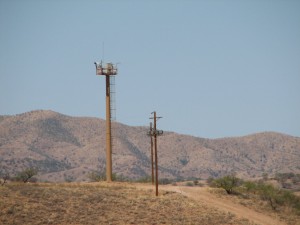Radar Sweeps in the Desert
These cameras have been around for some time. The building next door is where Customs and Border Protection has some of the newest technology, but I wasn’t allowed to visit. That is where agents receive information from more than a dozen surveillance towers in the desert that use both cameras and radar. They are called “integrated fixed towers.” Their radar sweeps for drug smugglers and illegal border crossers, and they transmit video. “Our agents can then determine whether that sweep is picking up, whether it is an animal, whether it is a person, whether it is a vehicle,” says Mitchell.
Those fixed towers were originally put up by Boeing, the contractor. They are still functional, but the bigger project Boeing tried to create -- an elaborate virtual fence called SBInet that would have integrated radar, cameras and sensors all along the Southwest border -- was deemed a failure. Thad Bingel, a Washington-based security consultant who used to be the chief of staff at Customs and Border Protection, explains the problems with the virtual fence like this: “The issue with SBInet was that it was overly ambitious,” he says.
There were missed deadlines, system bugs and escalating costs. After pouring a billion dollars into it without success, then-Homeland Security Secretary Janet Napolitano canceled SBInet in 2011. And it prompted the federal government to rethink how it approaches border technology. “It really caused an examination within the agency of going back and saying, ‘OK, we tried to design a system that did a lot of things, but didn't do it all very well, so let's focus instead on what do you actually need in these different places,’ ” says Bingel.
Huge Ground Surveillance Contract Bids
What they’ve decided they need is to start in southern Arizona with a $1.5 billion plan that includes more cameras and more integrated fixed towers. California sector chiefs hope for similar technology eventually. For now, competition for the Arizona contracts is heating up. The bid for towers will be the single-biggest ground surveillance contract since SBInet. But this time, the contracting process has changed.
Mark Borkowski works for the border agency’s Office of Technology Innovation and Acquisition. That’s a new office set up to prevent SBInet-size mistakes. He says a lot of things are different. This time, the agency doesn’t want to see just paper proposals. A half-dozen finalist companies had to build models and prove that their towers work -- on their own dime. This June the finalists -- which reportedly include Raytheon, Lockheed Martin and General Dynamics -- showed off their towers in the desert.
Borkowski says they were tested on: “How far can your camera see, how far can your radar see, and how confident, how likely is it that if there is something out there, it will actually see it? We call that probability of detection,” he says.
Some outside analysts are applauding the agency for taking a more risk-averse approach. Werner Dahm directs a security research institute at Arizona State University. “Having something that works in place, and can do the job well, is better than having something that maybe is more spectacular from a technology point of view but that ultimately doesn’t end up working,” says Dahm.
The agency is expected to name a winner for the integrated fixed towers contract by the end of the year. Meanwhile, a controversy is brewing among landholders. They’re angry that the government is planning to take pieces of their land by eminent domain in order to install these towers.
